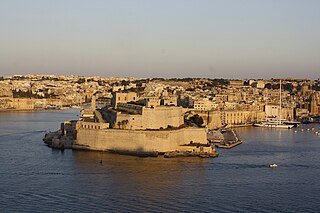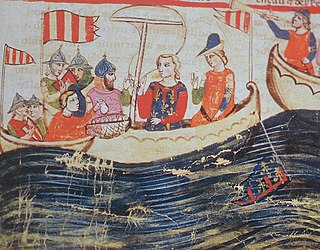Related Research Articles

Year 1299 (MCCXCIX) was a common year starting on Thursday of the Julian calendar.

Peter III of Aragon was King of Aragon, King of Valencia, and Count of Barcelona from 1276 to his death. At the invitation of some rebels, he conquered the Kingdom of Sicily and became King of Sicily in 1282, pressing the claim of his wife, Constance II of Sicily, uniting the kingdom to the crown.

Frederick II was the regent of the Kingdom of Sicily from 1291 until 1295 and subsequently King of Sicily from 1295 until his death. He was the third son of Peter III of Aragon and served in the War of the Sicilian Vespers on behalf of his father and brothers, Alfonso ΙΙΙ and James ΙΙ. He was confirmed as king by the Peace of Caltabellotta in 1302. His reign saw important constitutional reforms: the Constitutiones regales, Capitula alia, and Ordinationes generales.

Charles II, also known as Charles the Lame, was King of Naples, Count of Provence and Forcalquier (1285–1309), Prince of Achaea (1285–1289), and Count of Anjou and Maine (1285–1290); he also styled himself King of Albania and claimed the Kingdom of Jerusalem from 1285. He was the son of Charles I of Anjou—one of the most powerful European monarchs in the second half of the 13th century—and Beatrice of Provence. His father granted Charles the Principality of Salerno in the Kingdom of Sicily in 1272 and made him regent in Provence and Forcalquier in 1279.

The Battle of Cape Ecnomus or Eknomos was a naval battle, fought off southern Sicily, in 256 BC, between the fleets of Carthage and the Roman Republic, during the First Punic War. It was the largest battle of the war and one of the largest naval battles in history. The Carthaginian fleet was commanded by Hanno and Hamilcar; the Roman fleet jointly by the consuls for the year, Marcus Atilius Regulus and Lucius Manlius Vulso Longus. It resulted in a clear victory for the Romans.

A galley is a type of ship that is propelled mainly by oars. The galley is characterized by its long, slender hull, shallow draft, and low freeboard. Virtually all types of galleys had sails that could be used in favorable winds, but human effort was always the primary method of propulsion. This allowed galleys to navigate independently of winds and currents. The galley originated among the seafaring civilizations around the Mediterranean Sea in the late second millennium BC and remained in use in various forms until the early 19th century in warfare, trade, and piracy.

The Battle of Malta took place on 8 July 1283 in the entrance to the Grand Harbour, the principal harbour of Malta, as part of the War of the Sicilian Vespers. An Aragonese fleet of galleys, commanded by Roger of Lauria, attacked and defeated a fleet of Angevin galleys commanded by Guillaume Cornut and Bartholomé Bonvin.

Roger of Lauria (c. 1245 – 17 January 1305) was a Calabrian admiral in Aragonese service, who was the commander of the fleet of the Crown of Aragon during the War of the Sicilian Vespers. He was probably the most successful and talented naval tactician of the Middle Ages. He is known as Ruggero or Ruggiero di Lauria in Italian and Roger de Llúria in Catalan.

William Ledyard Rodgers was a vice admiral of the United States Navy. His career included service in the Spanish–American War and World War I, and a tour as President of the Naval War College. Rodgers was also a noted historian on military and naval topics, particularly relating to ancient naval warfare.

Galley tactics were the dominant form of naval tactics used from antiquity to the late 16th century when sailing ships began to replace oared ships as the principal form of warships. Throughout antiquity and the Middle Ages until the 16th century, the weapons relied on were the ship itself, used as a battering ram or to sink the opponent with naval rams, the mêlée weapons of the crew, missile weapons such as bolts from heavy crossbows fixed on the bulwarks, bows and arrows, weights dropped from a yard or pole rigged out, and the various means of setting an enemy alight. The latter could be done by shooting arrows with burning tow or by Greek fire ejected through specially designed siphons.

The naval Battle of the Gulf of Naples took place on 5 June 1284 in the south of the Gulf of Naples, Italy, when an Aragonese-Sicilian galley fleet commanded by Roger of Lauria defeated a Neapolitan galley fleet commanded by Charles of Salerno and captured Charles.

The naval Battle of the Counts took place on 23 June 1287 at Naples, Italy, when an Aragonese-Sicilian galley fleet commanded by Roger of Lauria defeated a large combined Angevin galley fleet commanded respectively by Reynald III Quarrel of Avella and Narjot de Toucy.
The naval Battle of Ponza took place on 14 June 1300 near the islands of Ponza and Zannone, in the Gulf of Gaeta, when a galley fleet commanded by Roger of Lauria defeated an Aragonese-Sicilian galley fleet commanded by Conrad d'Oria.

Aci Castello is a comune in the Metropolitan City of Catania in Sicily, Italy. The city is located 9 kilometres (6 mi) north of Catania on the Mediterranean coast. The primary economic sectors are agriculture and industry. The city is neighbored by Aci Catena, Acireale, Catania, San Gregorio di Catania and Valverde.
The Treaty of Anagni was an accord between the Pope Boniface VIII, James II of Aragon, Philip IV of France, Charles II of Naples, and James II of Majorca. It was signed on 20 June 1295 at Anagni, in central Italy. The chief purpose was to confirm the Treaty of Tarascon of 1291, which ended the Aragonese Crusade. It also dealt with finding a diplomatic solution to the conquest of Sicily by Peter III of Aragón in 1285.

The War of the Sicilian Vespers, also shortened to the War of the Vespers, was a conflict waged by several medieval European kingdoms over control of Sicily from 1282 to 1302. The war, which started with the revolt of the Sicilian Vespers, was fought over competing dynastic claims to the throne of Sicily, and grew to involve the Kingdom of Aragon, the House of Anjou, France, and the papacy.

The Battle of the Col de Panissars was fought on 30 September and 1 October 1285 between the forces of Philip III of France and Peter III of Aragon. It was a severe defeat for the French, who were already retiring over the Pyrenees when the Aragonese fell on them.
An incomplete list of events in 1299 in Italy:
Blasco I Alagona or d'Alagona, called the Elder, was an Aragonese nobleman and soldier in the service of the Kingdom of Sicily after 1285. His family was originally from Alagón. As a military commander, he was noted for his adept use of mobile infantry against heavy cavalry.

The Genoese navy was the naval contingent of the Republic of Genoa's military. From the 11th century onward the Genoese navy protected the interests of the republic and projected its power throughout the Mediterranean and Black Seas. It played a crucial role in the history of the republic as a thalassocracy and a maritime trading power.
References
- ↑ Rodgers, William Ledyard (1939). Naval Warfare Under Oars, 4th to 16th Centuries: A Study of Strategy, Tactics and Ship Design. Naval Institute Press. p. 139.
- 1 2 3 4 5 6 Rodgers, William Ledyard (1939). Naval Warfare Under Oars, 4th to 16th Centuries: A Study of Strategy, Tactics and Ship Design. Naval Institute Press. p. 140.
- 1 2 The Encyclopedia of War. Dorling Kindersley. 2012. p. 91.
- 1 2 3 Rodgers, William Ledyard (1939). Naval Warfare Under Oars, 4th to 16th Centuries: A Study of Strategy, Tactics and Ship Design. Naval Institute Press. p. 141.
- ↑ Grant, R.G. (2010). Battle at Sea: 3000 Years of Naval Warfare . Dorling Kindersley. p. 71.
- 1 2 Tucker, Spencer C. (2009). A Global Chronology of Conflict: From the Ancient World to the Modern Middle East. ABC-CLIO. p. 293.